#anthro.atlas
Photo

The triple division of the Slavic languages
by anthro.atlas
The Slavic languages, one of the major subfamilies of the Indo-European languages, are usually divided into three branches: East (e.g., Russian and Belarussian), South (e.g., Serbo-Croatian and Bulgarian), and West (e.g., Polish and Slovak). Some scholars contend, however, that this division is mostly based on extralinguistic factors, such as the speakers’ divergent ideological and religious views. For instance, some argue that some languages and dialects are misclassified due to political factors (e.g., Rusyn and Silesian) and that there are only two main branches, the South and the North (which includes the East and West Slavic languages). Sources: Ethnologue (2023) & Tomasz Kamusella’s paper, “The Triple Division of the Slavic Languages” (2005)
204 notes
·
View notes
Photo
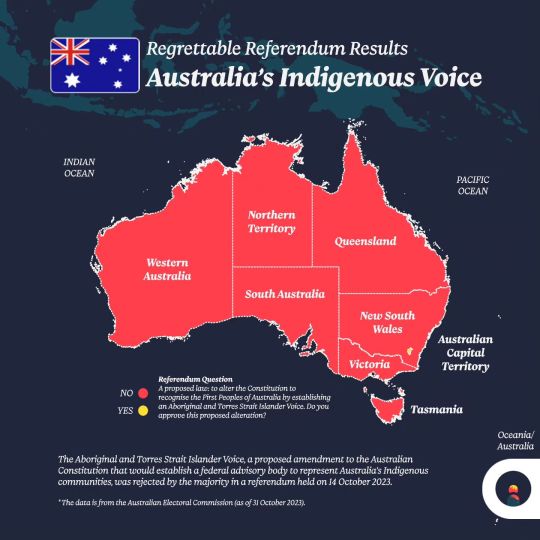
Australian Indigenous Voice Referendum, 2023.
On 14 October 2023, a referendum was held to establish the Aboriginal and Torres Strait Islander Voice, also referred to as the First Nations Voice, the Indigenous Voice to Parliament, or just the Voice.
The Voice, a proposed amendment to the Australian Constitution, would establish a federal advisory body to represent the views of Australia’s Indigenous communities and would be a way to address the disadvantages faced by these communities. However, the Voice proposal failed to receive the double majority required by the Australian Constitution because it was rejected both nationally and by the majority in each state. The only state or territory with a majority of “yes” votes was the Australian Capital Territory. Areas with a significant Indigenous Australian population also overwhelmingly voted in favour.
Sources:
“Aboriginal and Torres Strait Islander Voice.” National Indigenous Australians Agency. 2023.
Advisory Report on the Constitution Alteration (Aboriginal and Torres Strait Islander Voice). May 2023.
Australian Electoral Commission. 31 October 2023.
by anthro.atlas
208 notes
·
View notes
Photo
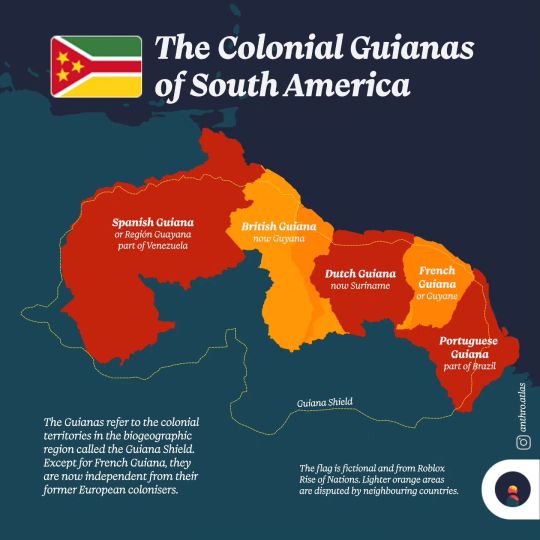
The Five Guianas
by anthro.atlas
The colonial territories in the biogeographic area known as the Guiana Shield are referred to as the Guianas. In an indigenous South American language, the name Guyana or Guayana means “land of many waters.” In the fifteenth century, Europeans began to explore and eventually colonise the Guianas. With the exception of French Guiana, these territories are now sovereign. It should be noted that some sections in this region are disputed: part of Maripasoula between Guyana and French Guiana, lower East Berbice-Corentyne between Suriname and Guyana, and Guayana Esequiba between Venezuela and Guyana.
119 notes
·
View notes
Photo
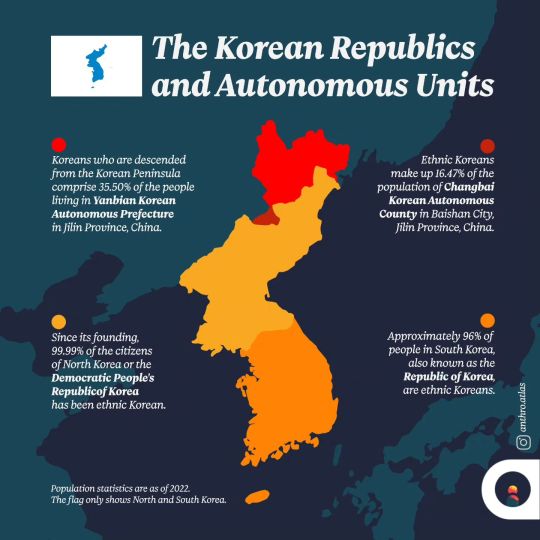
The Four Koreas
by anthro.atlas
With ethnic Koreans making up 99.99% of the population in North Korea and 95.63% in South Korea, these two countries are among the most homogeneous in the world. Outside these republics, however, there are two political entities where a substantial Korean population resides. These are Yanbian Korean Autonomous Prefecture and Changbai Korean Autonomous County, both in China’s Jilin Province. Majority of the Koreans residing in Yanbian, in contrast to those in Changbai and the Korean republics, are descended from migrants who left the Korean Peninsula in large numbers throughout the 19th and 20th centuries.
Sources: National Bureau of Statistics of the People’s Republic of China & National Bureau of Statistics (South Korea)
107 notes
·
View notes
Photo

The shrinking Aral Sea.
The Aral Sea was a lake in Central Asia that straddled the boundary between Kazakhstan and Uzbekistan. The lake’s name, which translates to “sea of islands” in Turkic and Mongolic languages, derives from the thousand islands that used to dot its waters. As a result of Soviet irrigation projects in the 1960s that blocked the major rivers that fed the lake, the Aral Sea started to decrease.
The lake is now less than 10% of its original size and has split into four bodies: the North Aral Sea, the Barsakelmes Lake, and the west and east parts of the South Aral Sea. Kazakhstan constructed a dam to replenish the North Aral Sea with water, but environmental advocates, policymakers, and scientists are skeptical that the entire lake can be revived.
by anthro.atlas
165 notes
·
View notes
Photo
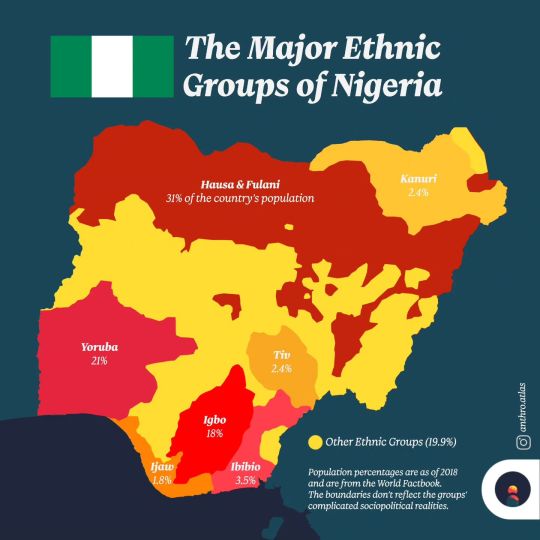
Ethnic groups of Nigeria
The Federal Republic of Nigeria is home to between 250 and 400 distinct ethnic groups and around 500 different spoken languages. However, only eight major ethnic groups comprise 81% of the population (2018 estimate), and these groups are the Hausa, Fulani, Yoruba, Igbo, Ibibio, Kanuri, Tiv, and Ijaw. The great ethnic diversity of the nation has its benefits and drawbacks. On the one hand, it showcases Nigeria’s vibrant cultural tapestry. However, it has also played a part in the long-term political, economic, and religious conflicts that have afflicted the nation. Sources: Federal Ministry of Information and National Orientation (Nigeria) & World Factbook
by anthro.atlas
80 notes
·
View notes
Photo

The Two Mongolias
The native Mongolian peoples have historically lived in the Mongolian People’s Republic and the Inner Mongolia Autonomous Region in the People’s Republic of China, which together once comprised Greater Mongolia. While Inner Mongolia is an autonomous subnational division of China, the nation of Mongolia (sometimes known as Outer Mongolia) is a free and open state with a democratic government.
Political and historical reasons led to the split of Mongolia into these two regions. One important contributing aspect is that, in the 19th century, Han Chinese farmers were drawn to the Mongolian region in search of land to cultivate due to population pressure in China’s south. Conflicts with herders resulted from this, and Outer Mongolia gained independence in 1912 and Inner Mongolia gained administrative autonomy in 1932.
Is a reunion between the two Mongolias possible?
Sources:
Beal, Rich. "A tale of two Mongolias." Koryo Group. 14 October 2020.
Salisbury, Harrison E. "The two Mongolias are bitter enemies." The New York Times. 17 October 1977.
by anthro.atlas
116 notes
·
View notes
Photo

Peru-Bolivian Confederation
by anthro.atlas
he Confederación Perú-Boliviana (Peru-Bolivian Confederation) was a state in South America that existed from 1836 until 1839. It was a union of the three states of North Peru, South Peru, and Bolivia, as well as the two administrative areas of Carhuaucran and Arica. It encompassed the entirety of modern-day Peru and Bolivia, along with portions of Argentina, Brazil, Chile, Colombia, Ecuador, and Paraguay. Territorial disputes with neighbouring states and competing political interests were among the internal and foreign factors that ultimately brought the confederation to an end. Source: Decreto del 28 de Octubre de 1836 (Establecimiento de la Confederación Perú-Boliviana)
58 notes
·
View notes
Photo

Diplomatic missions of North Korea in European countries.
In a letter posted on the website of the People’s Communist Party of Spain last month, the Democratic People’s Republic of Korea, commonly known as North Korea, stated it was closing its embassy in Spain. The leaders of Angola and Uganda also received “farewell” visits from North Korean ambassadors recently, according to North Korea’s state media.
The South Korean Ministry of Reunification claims that a fourth of North Korea’s 53 diplomatic missions in the Americas, Africa, Asia, and Europe are also scheduled to close. Analysts say that the closure of these embassies is a sign that international sanctions are making it harder for North Korea to earn money.
What impact do you believe the closures will have on North Korea’s internal relations?
Sources:
“Fin de la misión diplomática de la República Popular de Corea en el estado Español.” Partido Comunista de los Pueblos de España. 28 October 2023.
“N. Korea closes embassy in Spain following shutdown of missions in Africa.” The Korea Times. 1 November 2023.
O’Carroll, Chad. “North Korea to close embassy in Spain due to sanctions: Spanish political party.” NK News. 1 November 2023.
by anthro.atlas
61 notes
·
View notes
Photo
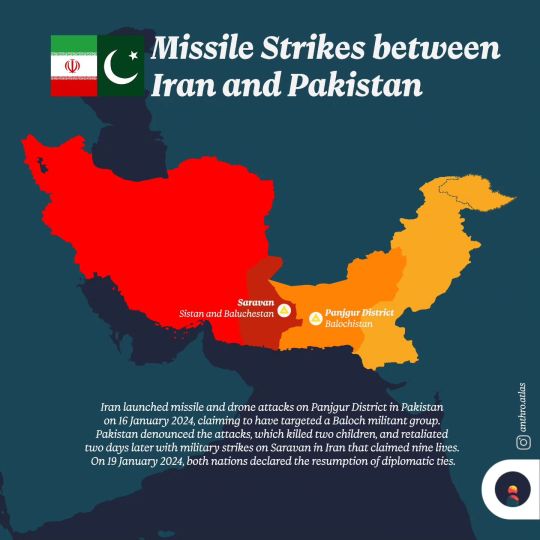
Iran-Pakistan crossfire, January 2024.
by anthro.atlas
Iran launched missile and drone attacks on the province of Balochistan in Pakistan on 16 January 2024, claiming to have targeted a militant group striving for the independence of the Baloch territories in Iran, Pakistan, and Afghanistan. Pakistan denounced the attacks, which killed two children and injured four others in Panjgur District. It retaliated two days later with military strikes on Saravan in the Iranian province of Sistan and Baluchestan that claimed the lives of nine foreign nationals. On 19 January 2024, both nations declared the resumption of diplomatic ties, following their agreement to defuse the tensions.
40 notes
·
View notes
Photo

Conflict in Nagorno-Karabakh
Nagorno-Karabakh was a region of the Azerbaijan Soviet Socialist Republic contested by Armenia and Azerbaijan. The Armenian-led Republic of Artsakh gained control of it and surrounding areas from 1994 until Azerbaijan captured significant areas in 2020 and launched an offensive in 2023 that led to the surrender of Artsakh forces and the exodus of Armenians from Nagorno-Karabakh.
by anthro.atlas
64 notes
·
View notes
Photo
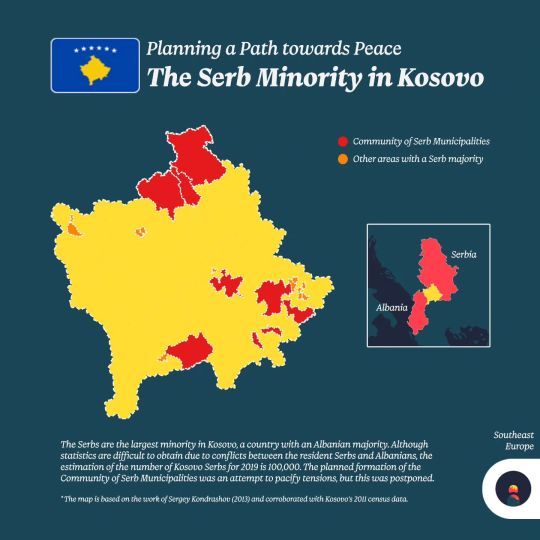
The Serb minority in Kosovo
The Serbs make up the largest minority of the population in Kosovo, a Balkan nation with an Albanian majority that proclaimed its independence from Serbia in 2008. Reliable statistics on the number of Serbs in Kosovo are difficult to obtain as a result of the complications caused by the wars and disagreements between the resident Serbs and Albanians. However, the usual estimation for 2019 is 100,000, down from around 300,000 in 1999.
In an attempt to pacify tensions in the country, the 2013 Brussels Agreement called for the formation of the Community of Serb Municipalities in Kosovo. But it was postponed due to conflicts, the most recent of which occurred in September 2023 when armed Serb paramilitaries assaulted a police patrol in northern Kosovo, killing one officer.
What do you think is the best way to bring Serbs and Albanians in Kosovo together in peace?
Sources:
Bechev, Dimitar. “Analysis: are Kosovo and Serbia on the brink of war?” Al Jazeera. 3 October 2023.
Judah, Tim. “Kosovo’s demographic destiny looks eerily familiar.” Reporting Democracy. 7 November 2019.
“Serbs.” Minority Rights Group. March 2018.
by anthro.atlas
41 notes
·
View notes